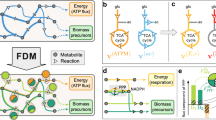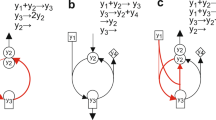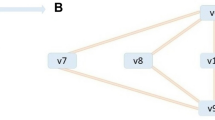Abstract
THEORIES of active biological transfer have been discussed in the light of the Curie principle1,2, which forbids the combination of a scalar force, such as the chemical affinity of a reaction, with a vector flux such as the diffusion flux of a solute2. In active transfer, solutes are transferred against their gradients of electrochemical potential by means of energy derived from metabolism. It has usually been stated that direct thermodynamic cross coupling between a chemical reaction and the flux of an active transfer cannot occur3 and, instead, the chemical reaction is supposed to modify the electrochemical potential of the transferred solute which then diffuses spontaneously.
This is a preview of subscription content, access via your institution
Access options
Subscribe to this journal
Receive 51 print issues and online access
$199.00 per year
only $3.90 per issue
Buy this article
- Purchase on Springer Link
- Instant access to full article PDF
Prices may be subject to local taxes which are calculated during checkout
Similar content being viewed by others
References
Jardetzky, O., Biochim. Biophys. Acta, 79, 631 (1964).
Vaidyanathan, V. S., J. Theoret. Biol., 9, 489 (1965).
Bray, H. G., and White, K., Kinetics and Thermodynamics in Biochemistry (Churchill, London, 1957).
Whittam, R., Wheeler, K. P., and Blake, A., Nature, 203, 720 (1964).
Mitchell, P., Biochem. Soc. Symp., 22, 142 (1963).
Kedem, O., in Membrane Transport and Metabolism (edit. by Kleinzeller, A., and Kotyk, A.), 205 (Academic Press, New York, 1961).
Acland, J. D., J. Theoret. Biol., 13, 318 (1966).
Eyring, H., and Eyring, E. M., Modern Chemical Kinetics (Reinhold, New York, 1963).
de Groot, S. R., Thermodynamics of Irreversible Processes (North Holland, Amsterdam, 1958).
Guggenheim, E. A., in The Transition State, 27 (The Chemical Society, London, 1962).
Vennesland, B., Fed. Proc., 17, 1150 (1958).
Levy, H. R., and Vennesland, B., J. Biol. Chem., 228, 85 (1957).
Skou, J. C., Physiol. Rev., 45, 596 (1965).
Prigogine, I., and Defay, R., (translated by Everett, D. H.), chemical Thermodynamics (Longmans, London, 1954).
Jardetzky, O., Nature, 211, 969 (1966).
Vidaver, G. A., J. Theoret. Biol., 10, 301 (1966).
Author information
Authors and Affiliations
Rights and permissions
About this article
Cite this article
ACLAND, J. Vectorial Metabolism. Nature 215, 78–79 (1967). https://doi.org/10.1038/215078a0
Received:
Revised:
Issue Date:
DOI: https://doi.org/10.1038/215078a0
Comments
By submitting a comment you agree to abide by our Terms and Community Guidelines. If you find something abusive or that does not comply with our terms or guidelines please flag it as inappropriate.



